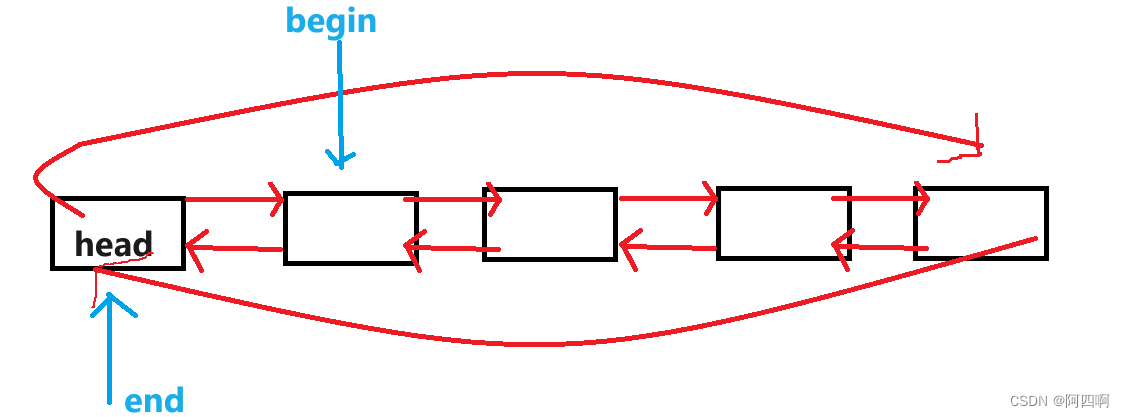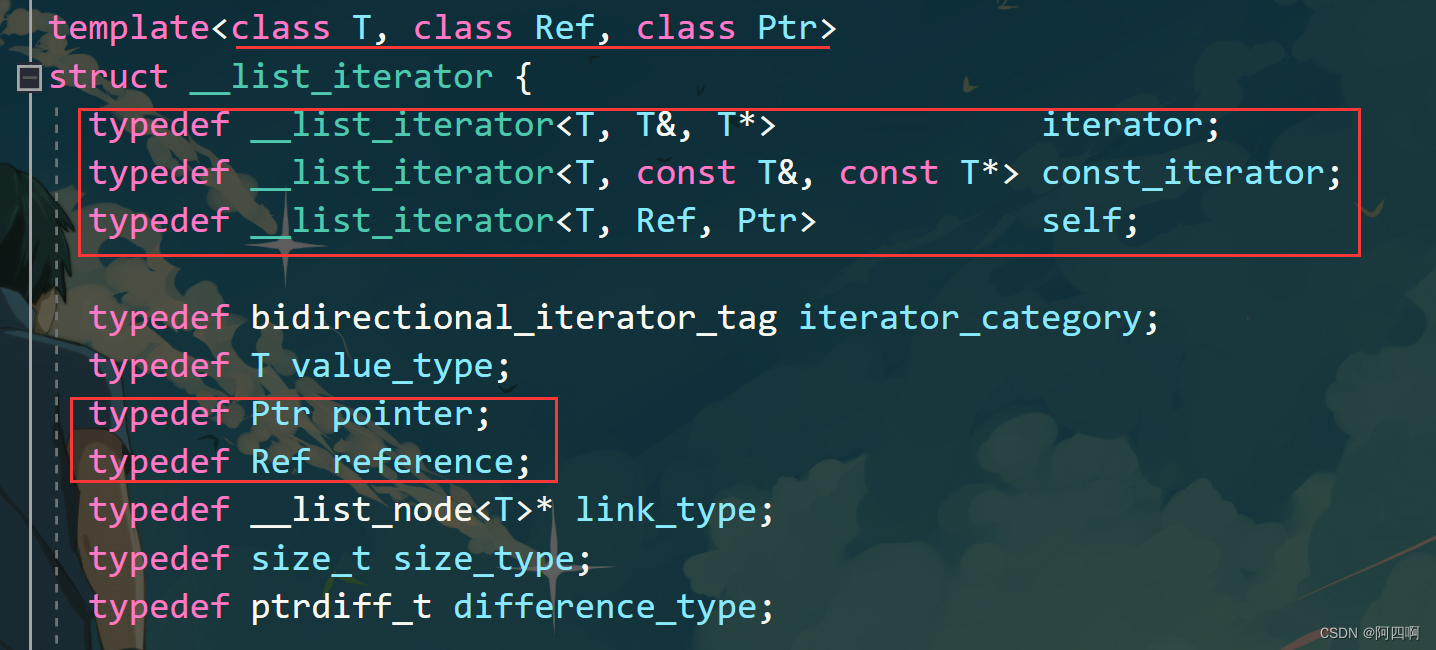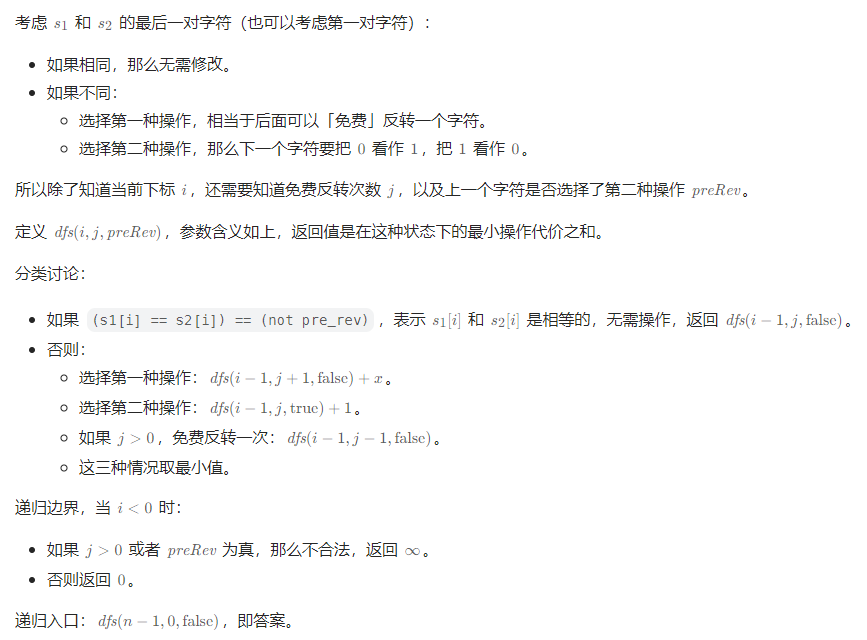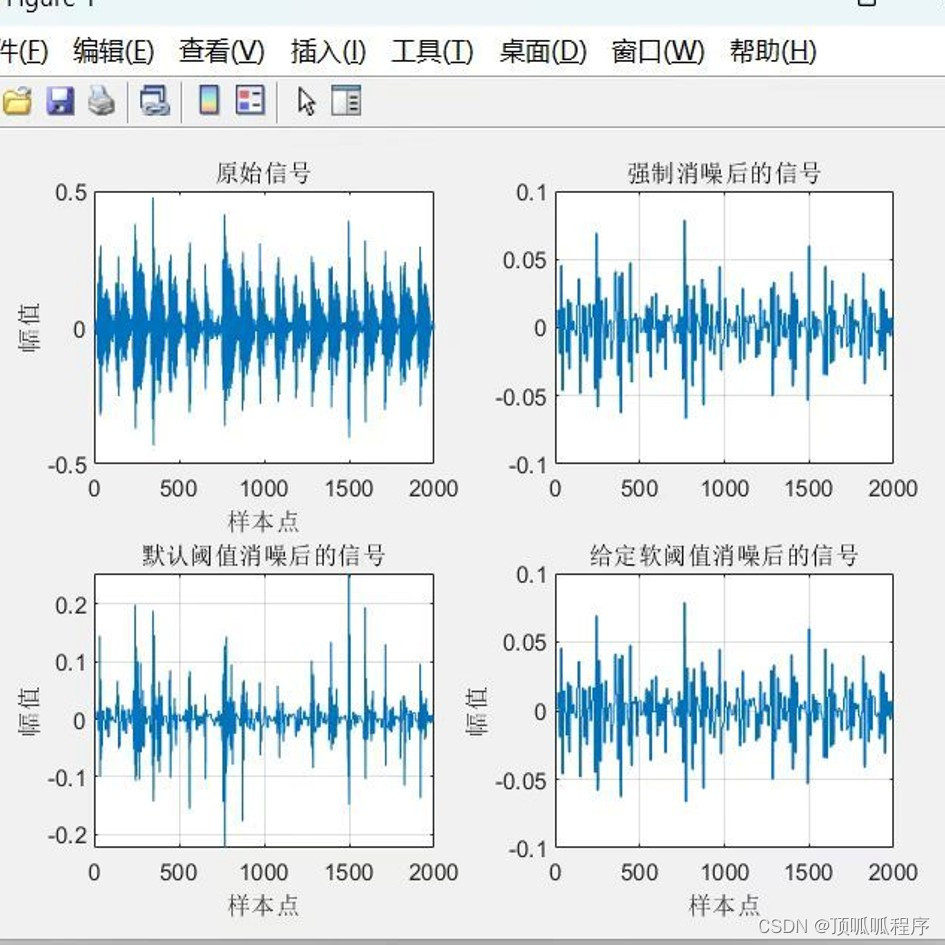
👻内容专栏: C/C++编程
🐨本文概括:list的介绍与使用、深度剖析及模拟实现。
🐼本文作者: 阿四啊
🐸发布时间:2023.10.12
一、list的介绍与使用
1.1 list的介绍
cpluplus网站中有关list的介绍👉 list的文档介绍

list是可以在常数范围内在任意位置进行插入和删除的序列式容器,并且该容器可以前后双向迭代。list的底层是双向链表结构,双向链表中每个元素存储在互不相关的独立节点中,在节点中通过指针指向其前一个元素和后一个元素。list与forward_list非常相似:最主要的不同在于forward_list是单链表,只能朝前迭代,已让其更简单高效。- 与其他的序列式容器相比(
array,vector,deque),list通常在任意位置进行插入、移除元素的执行效率更好。 - 与其他序列式容器相比,
list和forward_list最大的缺陷是不支持任意位置的随机访问,比如:要访问list的第6个元素,必须从已知的位置(比如头部或者尾部)迭代到该位置,在这段位置上迭代需要线性的时间开销;list还需要一些额外的空间,以保存每个节点的相关联信息(对于存储类型较小元素的大list来说这可能是一个重要的因素)
1.2 list的使用
list中的接口也比较多,此处的学习也是类似,只需要掌握如何正确的使用,然后再去深入研究底层的原理,已达到可扩展的能力。以下为list要学习的常用接口。
1.2.1 list的构造
| 构造函数constructor | 接口说明 |
|---|---|
| list (size_type n, const value_type& val = value_type() | 构造的list中包含n个值为val的元素 |
| list() | 无参构造list |
| list (const list& x) | 拷贝构造函数 |
template <class InputIterator> list (InputIterator first, InputIterator last) | 用[first,last)区间的元素构造list |
以下为list的四种构造方式。我们通常使用迭代器遍历访问list,由于list是一种双向链表,不支持随机访问,所以不能像数组一样使用[]操作符来访问元素。
代码演示:
#include<iostream>
#include<list>
#include<string>
#include<vector>
using namespace std;
//list的使用及测试
void test_list1()
{//无参初始化list<int> lt1;lt1.push_back(1);lt1.push_back(2);lt1.push_back(3);lt1.push_back(4);list<int>::iterator it1 = lt1.begin();while (it1 != lt1.end()){cout << *it1 << " ";it1++;}cout << endl;//n个val初始化list<string> lt2(10,"xxx");list<string>::iterator it2 = lt2.begin();while (it2 != lt2.end()){cout << *it2 << " ";it2++;}cout << endl;//迭代器区间初始化int arr[] = { 10, 20, 30, 40 };list<int> lt3(arr, arr + sizeof(arr) / sizeof(*arr));list<int>::iterator it3 = lt3.begin();while (it3 != lt3.end()){cout << *it3 << " ";it3++;}cout << endl;//拷贝构造list<int> lt4(lt3);list<int>::iterator it4 = lt4.begin();while (it4 != lt4.end()){cout << *it4 << " ";it4++;}cout << endl;}
1.2.2 list iterator的使用
此处,大家可暂时将迭代器理解为一个指针(有关于迭代器我们还会在后面章节讲解到),该指针指向list中的某个节点。
| 函数声明 | 接口说明 |
|---|---|
| begin + end | 返回第一个元素的迭代器+返回最后一个元素下一个位置的迭代器 |
| rbegin + rend | 返回第一个元素的reverse_iterator,即end位置,返回最后一个元素下一个位置的reverse_iterator,即begin位置 |
注意⚠️:
- begin与end为正向迭代器,对迭代器执行++操作,迭代器向后移动
- rbegin(end)与rend(begin)为反向迭代器,对迭代器执行++操作,迭代器向前移动。
代码演示:
// list迭代器的使用
// 注意:遍历链表只能用迭代器和范围for
void PrintList(const list<int>& l)
{// 注意这里调用的是list的 begin() const,返回list的const_iterator对象for (list<int>::const_iterator it = l.begin(); it != l.end(); ++it){cout << *it << " ";// *it = 10; 编译不通过}cout << endl;
}void test_list2()
{int array[] = { 1, 2, 3, 4, 5, 6, 7, 8, 9, 0 };list<int> l(array, array + sizeof(array) / sizeof(array[0]));// 使用正向迭代器正向list中的元素// list<int>::iterator it = l.begin(); // C++98中语法auto it = l.begin(); // C++11之后推荐写法while (it != l.end()){cout << *it << " ";++it;}cout << endl;// 使用反向迭代器逆向打印list中的元素// list<int>::reverse_iterator rit = l.rbegin();auto rit = l.rbegin();while (rit != l.rend()){cout << *rit << " ";++rit;}cout << endl;
}
1.2.3 list capacity
| 函数声明 | 接口说明 |
|---|---|
| empty | 检测list是否为空,是返回true,否则返回false |
| size | 返回list中有效节点的个数 |
1.2.4 list element access
| 函数声明 | 接口说明 |
|---|---|
| front | 返回list的第一个节点中值的引用 |
| back | 返回list的最后一个节点中值的引用 |
1.2.5 list modifiers
| 函数声明 | 接口说明 |
|---|---|
| push_front | 在list首元素前插入值为val的元素 |
| pop_front | 删除list中第一个元素 |
| push_back | 在list尾部插入值为val的元素 |
| pop_back | 删除list中最后一个元素 |
| insert | 在list position 位置中插入值为val的元素 |
| erase | 删除list position位置的元素 |
| swap | 交换两个list中的元素 |
| clear | 清空list中的有效元素 |
| resize | 改变size |
代码演示:
// list插入和删除
// push_back/pop_back/push_front/pop_front
void test_list3()
{int array[] = { 1, 2, 3 };list<int> L(array, array + sizeof(array) / sizeof(array[0]));// 在list的尾部插入4,头部插入0L.push_back(4);L.push_front(0);PrintList(L);// 删除list尾部节点和头部节点L.pop_back();L.pop_front();PrintList(L);
}// insert /erase
void test_list4()
{int array1[] = { 1, 2, 3 };list<int> L(array1, array1 + sizeof(array1) / sizeof(array1[0]));// 获取链表中第二个节点auto pos = ++L.begin();cout << *pos << endl;// 在pos前插入值为4的元素L.insert(pos, 4);PrintList(L);// 在pos前插入5个值为5的元素L.insert(pos, 5, 5);PrintList(L);// 在pos前插入[v.begin(), v.end)区间中的元素vector<int> v{ 7, 8, 9 };L.insert(pos, v.begin(), v.end());PrintList(L);// 删除pos位置上的元素L.erase(pos);PrintList(L);// 删除list中[begin, end)区间中的元素,即删除list中的所有元素L.erase(L.begin(), L.end());PrintList(L);
}// resize/swap/clear
void test_list5()
{// 用数组来构造listint array1[] = { 1, 2, 3 };list<int> l1(array1, array1 + sizeof(array1) / sizeof(array1[0]));PrintList(l1);// 交换l1和l2中的元素list<int> l2;l1.swap(l2);PrintList(l1);PrintList(l2);// 将l2中的元素清空l2.clear();cout << l2.size() << endl;
}
1.2.6 operations
| 函数声明 | 接口说明 |
|---|---|
| splice | 将元素从一个list转移到另一个list |
| remove | 删除具体值元素 |
| unique | 删除重复值元素 |
| merge | 合并排序列表 |
| sort | 对list容器中的元素进行排序 |
| reverse | 逆置元素 |
对于sort的成员函数大家可能有疑问了,算法库里面不是有sort吗?为什么自己还需要另外实现一个sort呢?
这里我们就需要讲解一下迭代器的分类问题了,iterator 按功能上分为const修饰的正反向迭代器与非const修饰的正反向迭代器,按性质上分为单向迭代器、双向迭代器、随机迭代器。
简单来说,单向迭代器支持++,常见的容器有单链表、哈希表。双向迭代器支持++/--,常见的容器有双向链表、红黑树(map/set),随机迭代器支持++/--/+/-,常见的容器有vector、string、deque

观察算法库里的sort,按形参说明就需要传入随机迭代器,但是list容器的底层迭代器属于双向迭代器,所以,这里对于list的sort得自己写一个成员函数。
以下简单写一些操作接口,稍微感受一下即可。
代码演示:
void test_list6()
{list<int> l1;l1.push_back(1);l1.push_back(2);l1.push_back(3);l1.push_back(4);l1.push_back(5);list<int>::iterator it = l1.begin();while (it != l1.end()){cout << *it << " ";it++;}cout << endl;l1.reverse();it = l1.begin();while (it != l1.end()){cout << *it << " ";it++;}cout << endl;//sort(l1.begin(), l1.end()); errorl1.sort();it = l1.begin();while (it != l1.end()){cout << *it << " ";it++;}cout << endl;list<int> l2;l2.push_back(1);l2.push_back(2);l2.push_back(3);l2.push_back(5);l2.push_back(2);l2.push_back(6);l2.push_back(7);l2.push_back(6);for (auto e: l2){cout << e << " ";}cout << endl;l2.sort();l2.unique();//对于不连续重复元素并不能达到去重效果,需要先进行排序for (auto e : l2){cout << e << " ";}cout << endl;l2.remove(3); //删除容器中指定的元素for (auto e : l2){cout << e << " ";}cout << endl;}
void test_list7()
{list<int> mylist1, mylist2;list<int>::iterator it;// set some initial values:for (int i = 1; i <= 4; ++i)mylist1.push_back(i); // mylist1: 1 2 3 4for (int i = 1; i <= 3; ++i)mylist2.push_back(i * 10); // mylist2: 10 20 30it = mylist1.begin();++it; // points to 2cout << "mylist1:";for (auto e : mylist1){cout << e << " ";}cout << endl;cout << "mylist2:";for (auto e : mylist2){cout << e << " ";}cout << endl;cout << "----------------------------------------" << endl;mylist1.splice(it, mylist2); // mylist1: 1 10 20 30 2 3 4// mylist2 (empty)// "it" still points to 2 (the 5th element)cout << "mylist1:";for (auto e : mylist1){cout << e << " ";}cout << endl;cout << "mylist2:";for (auto e : mylist2){cout << e << " ";}cout << endl;cout << "----------------------------------------" << endl;mylist2.splice(mylist2.begin(), mylist1, it);// mylist1: 1 10 20 30 3 4// mylist2: 2// "it" is now invalid.cout << "mylist1:";for (auto e : mylist1){cout << e << " ";}cout << endl;cout << "mylist2:";for (auto e : mylist2){cout << e << " ";}cout << endl;cout << "----------------------------------------" << endl;mylist2.splice(mylist2.end(), mylist1, mylist1.begin(), mylist1.end());//mylist1: //mylist2:2 1 10 20 30 3 4cout << "mylist1:";for (auto e : mylist1){cout << e << " ";}cout << endl;cout << "mylist2:";for (auto e : mylist2){cout << e << " ";}cout << endl;}
1.3 list的迭代器失效
前面说过,此处大家可将迭代器暂时理解成类似于指针(实际迭代器并不一定是原生态指针,在后面模拟实现list我们会了解,其实是进行封装了的iterator),迭代器失效即迭代器所指向的节点的无效,即该节点被删除了。因为list的底层结构为带头结点的双向循环链表,因此在list中进行插入时是不会导致list的迭代器失效的,只有在删除时才会失效,并且失效的只是指向被删除节点的迭代器,其他迭代器不会受到影响。
void TestListIterator1()
{int array[] = { 1, 2, 3, 4, 5, 6, 7, 8, 9, 0 };list<int> l(array, array+sizeof(array)/sizeof(array[0]));auto it = l.begin();while (it != l.end()){// erase()函数执行后,it所指向的节点已被删除,因此it无效,在下一次使用it时,必须先给其赋值//l.erase(it); errorit = l.erase(it);++it;}
}
二、list的模拟实现
要模拟实现list,必须要熟悉list的底层结构以及其接口的含义,通过上面的学习,这些内容已基本掌握,现在我们来模拟实现list。
2.1 list_node 节点类
首先我们还是命令一个MyList的空间,以表示与库里面的list进行区分。
首先使用struct封装每一个list的节点,因为里面的前驱_prev与后继_next到时候在外面使用时,需要进行外部访问,所以我们将list_node封装为struct,默认的限定符为public.
namespace MyList
{//list节点类template<class T>struct list_node{T _data;list_node<T>* _next;list_node<T>* _prev;list_node(const T& val = T()):_data(val), _next(nullptr), _prev(nullptr){}};
}
2.2 list的框架
因为有过数据结构链表的基础,这里多的细节不给大家详细介绍,list给一个头节点指针_head即可,有的版本也会给定一个_size,用来记录链表的节点个数。
写一个empty_init函数,表示空list的初始化工作,构造函数直接调用它,为什么不直接写到构造函数中,这在后面其他地方也会用到。
对于push_back尾插一个节点元素,我们不再像C语言那样写一个创建节点的函数,而这里我们可以直接new一个Node,节点类会去调用它的构造函数,然后链接到list的最后一个节点,双链表中,头节点的前驱指针_head->_prev指向的就是最后一个节点。另外,每每插入一个节点,_size++一下。
template<class T>
class list
{typedef list_node<T> Node;
public:void empty_init(){_head = new Node;_head->_next = _head;_head->_prev = _head;_size = 0;}list(){empty_init();}void push_back(const T& val){Node* tail = _head->_prev;Node* newnode = new Node(val);newnode->_prev = tail;tail->_next = newnode;newnode->_next = _head;_head->_prev = newnode;_size++;}size_t size(){return _size;}private:Node* _head;size_t _size;
};
2.3 list迭代器
我们思考一下,链表是怎么访问的呢?可以像string、vector一样使用访问操作符[]吗?,答案是,当然不能,因为string、vector在内存空间中数据是连续存储的,而list是利用内存中大量的空间内存碎片,使用指针连接而成,那么此时我们就需要用迭代器来访问了,迭代器该怎么写呢?难道可以像string、vector一样用原生指针表示吗,答案依旧不行,也正是因为list是非连续的内存存储结构,使用原生指针作为迭代器会导致一些错误的内存访问,这会导致程序崩溃或一些未定义行为,因为C语言学过,指针是涉及到算术运算的,因此,对于涉及到指针行为,我们需要进行封装迭代器!
这里大家可以简单查看一些stl库里面的list的头文件,它的封装是如何命名与书写的,文件已经上传到我的资源,点击访问-> 资源下载
库中将迭代器类命名为__list_iterator

我们将__list_iterator作为list迭代器实现的类,以下简称迭代器类,为了在类里面方便使用,我们将节点类list_node<T> typedef 为 Node,迭代器类里面,我们只有一个_node指针成员,构造函数参数当然也为Node*类型。
我们目的是将iterator封装,通过迭代器访问list的每一个元素,那么也就是达到和string、vector一样统一的访问效果,如以下图中表示:

图中的++、*、!=等等就是指针的一些行为。前面我们说过,list属于双向迭代器,有++,也有--操作,接下来我们就需要用到operator操作符重载,在日期类,我们就实现过前置++与后置++,有无一个int参数,构成他们之间的函数重载,前置++返回自增之后的值,后置++返回自增之前的值,提前将*this存储即可,前置--与后置--操作类似,我就不多赘述了。
_node = _node->_next:指针指向下一个节点。
_node = _node->_prev:指针指向前一个节点。
_node->_data:拿到迭代器指向的元素。
template<class T>
struct __list_iterator
{typedef list_node<T> Node;typedef __list_iterator Self;Node* _node;__list_iterator(Node* node){_node = node;}Self& operator++(){_node = _node->_next;return *this;}//后置++的重载,需要给定一个参数以区分前置++Self operator++(int){Self tmp(*this);_node = _node->_next;return tmp;}Self& operator--(){_node = _node->_prev;return *this;}Self operator--(int){Self tmp(*this);_node = _node->_prev;return tmp;}T& operator*(){return _node->_data;}//当前迭代器对象的_node与s迭代器对象的_node进行比较bool operator!=(const Self& s){return _node != s._node;}bool operator==(const Self& s){return _node == s._node;}
};
到这,我们可以继续编写list类。
前面说过,我们在使用的时候,注意到了list还是涉及到迭代器失效的问题,特别是erase删除数据之后,迭代器指向的节点无效。在网站标准文档中还是给出了返回一个iterator值,规避方法就是在下一次使用前,必须先给其赋值。
🔗库中insert返回值说明:

🔗库中erase返回值说明:

🔗list中beign与end的指向:

template<class T>
class list
{typedef list_node<T> Node;
public:typedef __list_iterator<T> iterator;void empty_init(){_head = new Node;_head->_next = _head;_head->_prev = _head;_size = 0;}list(){empty_init();}~list(){clear();delete _head;_head = nullptr;}iterator begin(){//return iterator(_head->_next);return _head->_next;}iterator end(){return _head;}void push_back(const T& val){/*Node* tail = _head->_prev;Node* newnode = new Node(val);newnode->_prev = tail;tail->_next = newnode;newnode->_next = _head;_head->_prev = newnode;*/insert(end(), val);}void push_front(const T& val){insert(begin(), val);}void pop_front(){erase(begin());}void pop_back(){erase(end()--);}void clear(){iterator it = begin();while (it != end()){it = erase(it);it++;}}iterator insert(iterator pos, const T& val){Node* cur = pos._node;Node* newnode = new Node(val);// cur->prev newnode cur cur->_prev->_next = newnode;newnode->_prev = cur->_prev;newnode->_next = cur;cur->_prev = newnode;_size++;return iterator(newnode);}iterator erase(iterator pos){Node* cur = pos._node;Node* prev = cur->_prev;Node* next = cur->_next;delete cur;_size--;return iterator(next);}size_t size(){return _size;}private:Node* _head;size_t _size;
};
测试:
void test_list1()
{list<int>lt;lt.push_back(1);lt.push_back(2);lt.push_back(3);lt.push_back(4);lt.push_back(5);list<int>::iterator it = lt.begin();while (it != lt.end()){cout << *it << " ";it++;}cout << endl;lt.insert(lt.begin(), 20);it = lt.begin();while (it != lt.end()){cout << *it << " ";it++;}cout << endl;
}
打印结果:
1 2 3 4 5
20 1 2 3 4 5
在这里我们并不好实现const类型的迭代器,并不是简单的const iterator,原因为何,待会需要结合其他知识说明。
2.4 拷贝构造与赋值重载
list的拷贝构造函数写法有许多种,这里给出简单通俗的方式,先调用empty_init()函数,使用范围for循环,给对象的每一个元素进行push_back即可,注意我们没有写const类型的迭代器,因此这里暂时去掉const,至于const类型的迭代器我们待会讲解。
list的赋值重载函数,我们可以复用写好的拷贝构造,使用现代写法,让编译器代替我们打工😉
//参数使用const修饰编译不通过,因为范围for,底层是利用了const的类型器,而我们没有实现const类型的
//iterator,const对象访问非const对象就会出现权利的放大,编译出错
//list(const list<T>& lt)
list(list<T>& lt)
{empty_init();for (auto e : lt){push_back(e);}
}lt1 = lt2
//list<T>& operator=(const list<T>& lt)
//{
// //传统写法
// if (*this != lt)
// {
// clear();
// for (auto e : lt)
// {
// push_back(e);
// }
// }
// return *this;
//}void swap(const list<T>& lt)
{std::swap(_head, lt._head);std::swap(_size, lt._size);
}
//lt1 = lt2
list<T>& operator=(list<T> lt)
{//现代写法swap(lt);return *this;
}
测试:
void test_list2()
{list<int>lt;lt.push_back(1);lt.push_back(2);lt.push_back(3);lt.push_back(4);lt.push_back(5);list<int>::iterator it = lt.begin();while (it != lt.end()){cout << *it << " ";it++;}cout << endl;list<int>lt1(lt);list<int>::iterator it1 = lt1.begin();while (it1 != lt1.end()){cout << *it1 << " ";it1++;}cout << endl;
}
打印结果:
1 2 3 4 5
1 2 3 4 5
2.5 list中存储自定义类型
若在list节点中存储自定义类型,通过直接用*it的方式去访问自定义类型中的数据会报错,究竟为什么呢?
其实和vector一样,编译器并不知道你要以哪种方式去打印,是元素之间添加空格呢还是冒号分隔还是换行呢?并不清楚,你只能自己对于每个自定义类型中的数据进行处理操作。
错误示范:
//像vector一样,对自定义类型本身不支持流插入
//所以在test_list3中使用<<访问会出错
struct A
{A(int a = 0,int b = 0):_a(a),_b(b){}int _a;int _b;
};
void test_list3()
{list<A> lt;lt.push_back(A(1, 2));lt.push_back(A(2, 3));lt.push_back(A(3, 4));list<A>::iterator it = lt.begin();while (it != lt.end()){// error C2679: 二元“<<”: 没有找到接受“T”类型的右操作数的运算符(或没有可接受的转换)//cout << *it << " "; //访问报错cout << (*it)._a << " " << (*it)._b << " ";//访问运算符 自定义类型.自定义类型成员it++;}cout << endl;
}
T* operator->()
{return &_node->_data;
}
让我们回顾一下指针访问内置类型和自定义类型的方式:

所以对于自定义类型,我们就可以在迭代器类中,重载一个operator->函数:
T* operator->()
{//->优先级高于&return &_node->_data;
}通过->访问自定义类型成员:
通过迭代器it + -> + 自定义类型成员就可以访问,但是仔细想想,咦?为什么这里不是it->->_a?
其实显式调用的时候应该这么写:it.operator->()->_a,实际是因为这么写可读性不好,编译器做了特殊处理,省略掉了中间的->
void test_list3()
{list<A> lt;lt.push_back(A(1, 2));lt.push_back(A(2, 3));lt.push_back(A(3, 4));list<A>::iterator it = lt.begin();while (it != lt.end()){cout << it->_a << " " << it->_b << " ";//显式地调用:cout << it.operator->()->_a << " " << it.operator->()->_b << " ";//本来应该是it->->_a,但是这样写可读性不好,于是编译器做了特殊处理,省略了一个->it++;}
}
所以,到这里我们更加深刻理解了为什么要封装iterator,对于指针的行为、数据的访问,使得更加灵活的访问,使得vector、list、set等容器的遍历访问具有统一性。
2.6 const类型的迭代器
到这里,迭代器类的封装,我们已经写的差不多了,不过对于刚才的疑惑const类型的迭代器我们该如何写?是直接在迭代器iterator前加个const吗?
例如这样,这样子就是const修饰iterator本身了,表示一旦初始化之后,就不能修改了。我们想要的结果是类似于iterator的const_iterator,他们两个本质是不同的对象,const_iterator表示迭代器指向的内容是常量,不可修改。也就是说我们实现的const_iterator只能读取容器中的元素,不能修改。
const list<int>::iterator it = lt.begin();
而我们只有再封装一个const_iterator版本的对象👇:
本质是对通过迭代器拿到的元素不能做修改,所以我们对于operator*和operator->的返回值加上const即可
template<class T>
struct __list_const_iterator
{typedef list_node<T> Node;typedef __list_const_iterator Self;Node* _node;__list_const_iterator(Node* node){_node = node;}Self& operator++(){_node = _node->_next;return *this;}//后置++的重载,需要给定一个参数以区分前置++Self operator++(int){Self tmp(*this);_node = _node->_next;return tmp;}Self& operator--(){_node = _node->_prev;return *this;}Self operator--(int){Self tmp(*this);_node = _node->_prev;return tmp;}//*it = 1;const T& operator*(){return _node->_data;}const T* operator->(){return &_node->_data;}bool operator!=(const Self& s){return _node != s._node;}bool operator==(const Self& s){return _node == s._node;}};
但是,大家不觉得这里的代码冗余度很高吗?我们只是对细微处作了修改,我们有没有什么办法,简化一下呢?没错,就是改变模板参数列表。
那么怎么改呢?我们看一下库中是如何写的:

库中的模板参数列表,给出了reference引用和pointer指针两个参数,对于const_iteratorconst类型的迭代器,我们只需在模板参数Ref和Ptr添加const修饰即可。
2.7 实现全容器的打印函数(深刻体会泛型编程的意义)
我们实现了const类型的迭代器之后,可以将写一个打印list的函数,
void print_list(const list<int>& lt)
{list<int>::const_iterator it = lt.begin();while (it != lt.end()){*it;cout << *it << " ";it++;}cout << endl;
}
void test_list4()
{list<int> lt;lt.push_back(1);lt.push_back(2);lt.push_back(3);lt.push_back(4);print_list(lt);
}
以上结果能够正确打印,但是对于list<string>这种类型的对象,以上函数也用不了,故我们需要实现一个模板函数:
list<T>是一个未实例化的模板,直接通过访问list<T>类模板名 + ::会报错,因为编译器就无法判断list<T>::iterator是内嵌类型还是静态成员变量,所以我们需要在其前面加一个typename,意思是告诉编译器这是一个类型,等到list<T>实例化后再去类里面读取。
//实例化
template<typename T>
//template<class T>
void print_list(const list<T>& lt)
{//list<T>未示例化的类模板,编译器不能去它里面去找//编译器就无法判断list<T>::iterator是内嵌类型还是静态成员变量//前面加一个typename就是告诉编译器,这里是一个类型,等到list<T>实例化后,//再去类里面读取typename list<T>::const_iterator it = lt.begin();while (it != lt.end()){*it;cout << *it << " ";it++;}cout << endl;
}
对此,我们还可以实现一个专门针对任意容器的打印函数。
template<typename Container>
void print_container(const Container& con)
{typename Container::const_iterator it = con.begin();while (it != con.end()){cout << *it << " ";it++;}cout << endl;
}
测试:
void test_list5()
{list<string> lt;lt2.push_back("11111");lt2.push_back("11111");lt2.push_back("11111");lt2.push_back("11111");print_list(lt2); vector<string> v;v.push_back("22222");v.push_back("22222");v.push_back("22222");v.push_back("22222");print_container(v);
}
打印结果:
11111 11111 11111 11111
22222 22222 22222 22222
三、list模拟实现源码
list深度剖析及模拟实现



![[GSEP202306 一级] C++ 时间规划](https://img-blog.csdnimg.cn/6131aae391834d87bf72fc4eb52d7e58.png)
